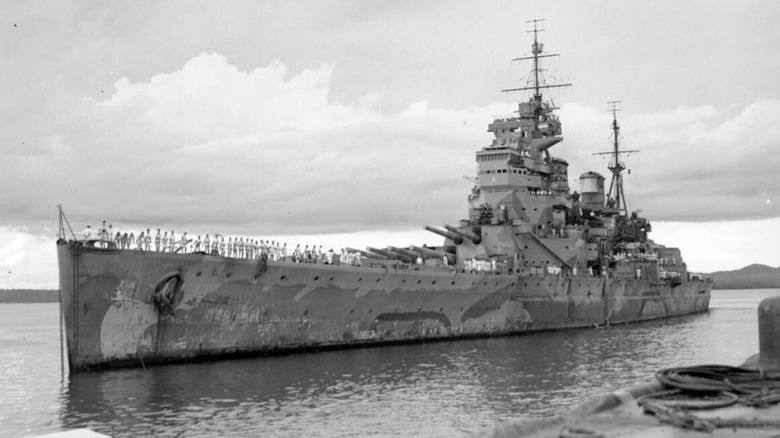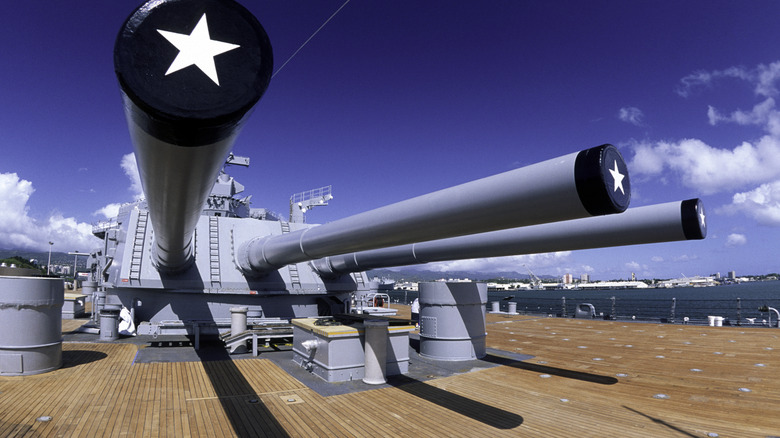How The Sinking Of The Prince Of Wales During WW2 Signaled The End For Battleships
The Second World War was fought on many fronts, with skirmishes occurring on land, in the air, and at sea alike. As a result, several forms of transportation and warfare became synonymous with the conflict. In the case of battles on open water, battleships stand as enduring images of this wartime era. These hulking ships moved soldiers, artillery, and more across vast expanses of ocean, taking the fight to the enemy. Despite their utility and contributions to the war effort then, in the modern era, the United States military doesn't make use of battleships anymore, nor do any other militaries around the world. This decision can be traced back to a pivotal moment during the war.
On December 10, 1941, the HMS Prince of Wales – A massive King George V-class battleship of the Royal Navy — was attacked by the Imperial Japanese Navy Air Service. Try as they might, both it and the HMS Repulse failed to fend off their exclusively aerial attackers. The two incredible ships were sunk in less than two hours, resulting in the loss of 840 people with the destruction of only four Japanese fighters to show for it. The defeat of these two ships effectively ushered in the end of the battleship age. It exposed their detrimental weaknesses to attacks from the skies, rendering them more of a liability than an asset on a quickly-evolving battlefield.
With the sinking of the Prince of Wales, it became abundantly clear that battleships were effectively obsolete in the 1940s. However, it would take decades for the remainder of their contemporaries to bow out of the spotlight.
[Featured image by Abrahams, HJ (Lt) via Wikimedia Commons | Cropped and scaled | CC0 1.0]
It took over five decades after the Prince of Wales sank for battleships to be retired
In the aftermath of the HMS Prince of Wales' demise, countries around the world continued to put their battleships to use. They may have been antiquated, but such forms of transportation and combat were utilized in the Korean Conflict of the 1950s, the Vietnam War of the 50s to the 70s, and even the Persian Gulf War of the early years of the 1990s. With that said, just because they were utilized, it didn't mean that the United States military, or any other for that matter, saw a future for them on the battlefield. In fact, such weapons of war wouldn't be carried into the 21st century.
By the start of the 1990s, the end of the battleship age was upon us. In 1992, the world's last U.S.-built and last active battleship was decommissioned. The USS Missouri's history dated back to World War II, participating in multiple conflicts and hosting the end of the conflict with Japan's formal surrender. It was used during the Korean Conflict before briefly retiring, only to return to action for the Gulf War. With the end of that conflict in 1991, the following year saw the Missouri's final farewell, avoiding being regarded among the worst battleships in military history and signaling the end of the world's use of battleships. It lives on as a museum, located in Pearl Harbor, Hawaii.
As the final battleship ever, the USS Missouri enjoys a new life as a tourist attraction. Sadly, the same cannot be said for the harbinger of the end of the battleship era, the HMS Prince of Wales.
What has become of the Prince of Wales' wreckage?
Naturally, given its size and the costs involved with such an expedition, the HMS Prince of Wales hasn't moved in the almost full century since it was destroyed. It remains at the bottom of the ocean, with its wreckage resting on the seabed off the coast of Malaysia. Like so many other battleships, it's not able to be visited by tourists and military historians, nor is any kind of major salvage and restoration project likely to happen. Worse yet, in recent years, the prominent World War II-era ship hasn't even been allowed to rest peacefully, with some bad actors taking it upon themselves to claim parts of the wreck as their own.
Tragically, a piece of World War II history has been repeatedly looted by those unauthorized to do so, per publications such as the UK Defence Journal. Portions of the ship and elements such as anchors have reportedly been stolen in recent years. The missing materials, specifically certain metals, have allegedly been taken to sell on underground, illegal markets. The same fate has befallen the HMS Repulse as well. The Malaysian government has overseen investigation efforts into the missing artifacts, though, at the time of publication, such efforts have yet to conclude. Time will tell what such inquiries yield.
At this point, the end of the battleship age has come. While one of the most legendary ships of World War II, the HMS Prince of Wales, and others were titans in their time, war changed too much too quickly for them to keep up, as evidenced by the sinking of the former.


